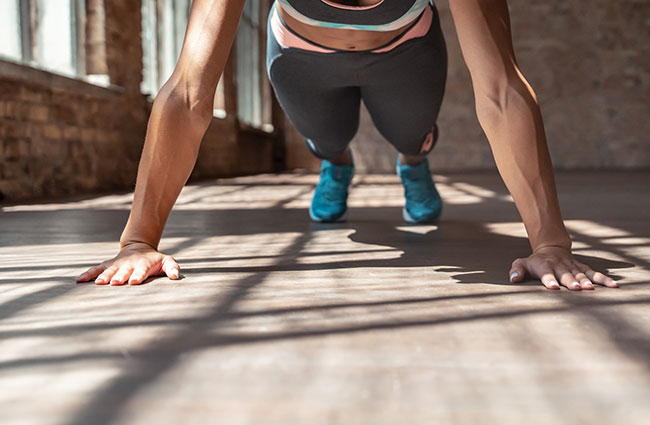
Fit for duty: Good to the core
Sherry Dean
Features Fitness editors pick Photo: insta_photos, GETTY IMAGES
Photo: insta_photos, GETTY IMAGES Most physical activities depend on well-conditioned core muscles. Almost everything you do is supported by your torso, including your abdominals, low back, pelvis and even hip flexors and glutes. The core is used to stabilize the thorax and the pelvis during the simplest dynamic movement. Even your overall balance is affected by a strong or weak core. Whether you are doing your job as a firefighter, playing a sport or even vacuuming, the activities you are doing are supported by an engaged torso. Having a good core is not about a chiseled six-pack, it’s about having a fully performing and strong trunk section.
Torso activation supports bending forward or backward, leaning from side to side, rotation of your upper body and moving your hips in any direction. Science studying the activation of core muscles using electrodes shows the core muscles are the first to fire in almost every activity we do. You may not think about your core when you are reaching to pull a transverse line, but if you pay attention it’s easy to recognize how fired your core is during the task.
Strong abdominals and a weak low back can lead to injury. Poor mobility, lower back pain and incontinence can all be the result of an imbalanced core. As one muscle engages, another must relax to allow for full unimpeded joint movement. Tight muscularity in one spot can cause your body to shift permanently until tight muscles are released and weak muscles are strengthened. It is essential to have a well-balanced core and not simply focus on sit-ups.
An overall regime of core conditioning and strengthening is by far the best approach. Spend as much time working on your back, pelvic and gluteal muscles as you do on your abs. Target the following muscle groups: rectus abdominus (six pack), internal and external obliques (side flexion/extension and rotation), erector spinae (flexion and rotation of vertebrae), pelvic floor (supports and stabilizes torso) and also include glute and hip flexor activation.
Muscles are muscles and your core needs rest too. Expect to have delayed onset of muscle soreness (DOMS) in your core when you are working it hard enough. You don’t have to do specific core exercises more frequently than any other body part.
Enjoy the workout and be safe.
Core Workout – 3 times through (modify as needed and work up to the full workout)
Elevated leg crunches: 10 on each side
- Lying on back, raise one leg to a 90-degree angle from your body and the other leg slightly lifted off of the floor. Neither foot touches the ground during this exercise. Reach toward your foot with the opposite hand. If you can’t touch your toes, reach as far as you can. Slowly lower your upper body back to the ground as you slowly switch leg positions. That’s one rep.
- Variation – Use your same leg side arm to reach behind the knee to support your reach toward the foot. Try not to pull your leg toward your head. The grip should only assist as much as needed and not doing all the work.
Twisting alternating lunges, weighted with extended arms, 15 on each side
Use a medicine ball or light weight. Lunge forward and ensure your lunge is kept low and strong (knee slightly off the ground, legs and core engaged). Extend your arms straight out and rotate 90 degrees to the side, then return to the center. Push back to a standing position. Alternate sides. You can complete either a forward or a rear lunge. There should be no rotational movement in your knees during the exercise.
Plank – 1-minute hold
- Each plank should be a different position. The first is a full prone with straight arms. Second set, right side plank. Third set, left side plank.
- Variation – move to the elbow and to knees if required to complete the entire minute. If one minute is too easy extend the time or add shoulder taps/toe taps
Hollow hold and Superman 30 secs X 3 each position (3 minutes)
- Lying supine, lift your feet and shoulders slightly off the ground, activating your core. Hold this position for 30 seconds, try to transition to the next position without using your hands. Stabilize and roll to a prone position keeping your shoulders and feet elevated. Pull your elbows to a 90-degree position with hands close to your shoulders and engage/squeeze your scapula together. Hold 30 secs. Return to hollow hold position without using your hands.
- Variation – use your hands to assist with transition from supine to prone positions.
V-ups X 15
- In a supine position raise both your upper and lower body simultaneously and bring your hands toward your feet. If you can’t touch your feet, reach as far as you can. Return to the supine position under control.
- Variation – bend the knees or complete leg-only raises.
Bridge X 15 with two-second top hold
- On your back with your feet firmly planted close to your glutes, raise your hips as far in the air as can, creating a straight line from your knees to your head. Hold the top position for two seconds and slowly lower your glutes back to the ground, but don’t disengage your core. Immediately raise your glutes again into a bridge and repeat.
- Variation – omit the two-second hold at the top
Sherry Dean is a career firefighter/engineer with Halifax Regional Fire & Emergency. She has more than 20 years of experience in fitness and training. Contact Sherry at deansherry@bellaliant.net.
Print this page
Advertisement
- Doctors, air pollution experts forecast worsening health effects of wildfire smoke
- Victoria crews battle commercial blaze